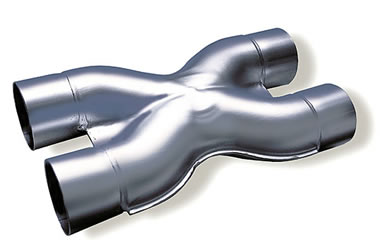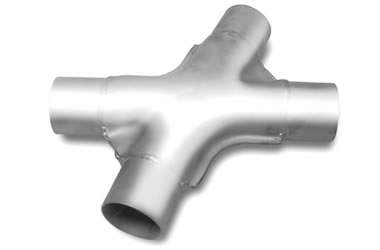It’s funny how a couple pieces of steel tubing can affect a vehicle’s performance. Yessir, get that exhaust system right and you’ll be rewarded with more power, better throttle response, and a great sound. Get it wrong, and all you’ll have is a car that runs like a slug and sounds like one, too.
Fortunately, there are companies like MagnaFlow to make sure your car won’t fall into the slug category. From mufflers and catalytic converters to complete cat-back exhaust systems, MagnaFlow has the stainless steel pipes you need to free up horsepower and get the deep performance growl that sends tingles down your spine.
One bit of tubing that makes a performance difference all out of proportion to its size is the crossover pipe. MagnaFlow makes one called the Tru-X crossover. But before we get into the particulars on the Tru-X, a lesson is in order.
Why Use a Crossover?
The primary function of a crossover is to equalize the flow of exhaust gas between each side of a dual exhaust system. By equalizing the flow between the pipes, the exhaust system can remove exhaust gas from the engine more efficiently. Exhaust pulses between opposing cylinder banks are smoothed out as well. The net result is a more efficient scavenging of exhaust gas from the cylinder heads, which pulls a fresh air/fuel charge into the engine quicker. And that means more power.
Crossovers come in two flavors. The H-pipe, or balance tube, connects each side of a dual exhaust system with a straight piece of tubing. This allows exhaust gas to move between the pipes, equalizing flow and backpressure between the two sides of the system.
The other type of crossover is the X-pipe. Instead of using a straight cross-tube to connect each side of the exhaust system, the X-pipe literally allows each side to cross over to the other. The advantages of the X-pipe include better exhaust scavenging and improved exhaust flow balance between the pipes.
(If you are interested in comparing X-pipes and H-pipes, learn more here.)
Why the Tru-X is Better
MagnaFlow’s Tru-X crossover does the X-pipe concept one better. It features gently radiused transitions that actually optimize the exhaust pulses moving through the system instead of just balancing them. That improves exhaust gas scavenging from the cylinders, which translates into more horsepower and torque.
The Tru-X pipe’s exhaust pulse optimization also improves noise cancellation—the ability to take opposing sound wave pulses in the exhaust and make them “cancel” themselves against each other—to lower exhaust decibel levels and improve the system’s overall tone.
Like virtually everything MagnaFlow makes, the Tru-X crossover pipes are mandrel-bent from stainless steel—one will probably outlast the rest of your vehicle. The Tru-X is standard equipment on many of MagnaFlow’s exhaust systems, and is also available by itself in 2 1/4-, 2 1/2-, and three-inch diameters. Try one out on your next dual exhaust system and see for yourself why X marks the horsepower spot!










me gusta todo.
[…] X pipe. As you can see over all, Magnaflow is the superior design and a TRUE X pipe. Read more "X" Marks the Spot: A Look at MagnaFlow's Tru-X Crossover Pipes – OnAllCylinders __________________ This Is The Sound That Will Make You Go Sick…. Convertible Crew # […]
has anyone tried using x-pipe on a 2009 bmw x5 ? and if anyone has is it still a quiet suv